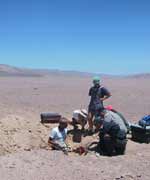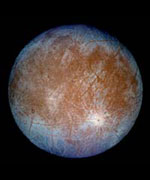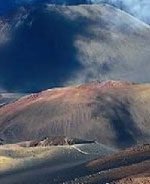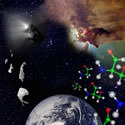
Image credit: NASA
A place so barren that NASA uses it as a model for the Martian environment, Chile’s Atacama desert gets rain maybe once a decade. In 2003, scientists reported that the driest Atacama soils were sterile.
Not so, reports a team of Arizona scientists. Bleak though it may be, microbial life lurks beneath the arid surface of the Atacama’s absolute desert.
“We found life, we can culture it, and we can extract and look at its DNA,” said Raina Maier, a professor of soil, water and environmental science at the University of Arizona in Tucson.
The work from her team contradicts last year’s widely reported study that asserted the “Mars-like soils” of the Atacama’s core were the equivalent of the “dry limit of microbial life.”
Maier said, “We are saying, ‘What is the dry limit of life?’ We haven’t reached it yet.”
The Arizona researchers will publish their findings as a letter in the Nov. 19 issue of the journal Science. Maier’s co-authors include UA researchers Kevin Drees, Julie Neilson, David Henderson and Jay Quade and U.S. Geological Survey paleoecologist Julio Betancourt. The project was funded by the National Science Foundation and the National Institute for Environmental and Health Sciences, part of the National Institutes of Health.
The project began not as a search for current life but rather as an attempt to peer into the past and reconstruct the history of the region’s plant communities. Betancourt and Quade, a UA professor of geosciences, have been conducting research in the Atacama for the past seven years.
Some parts of the Atacama have vegetation, but the absolute desert of the Atacama’s core — an area Betancourt describes as “just dirt and rocks” — has none.
Nor does the area have cliffs which harbor ancient piles of vegetation, known as middens, collected and stored by long-gone rodents. Researchers use such fossil plant remains to tell what grew in a place long ago.
So to figure out whether the area had ever been vegetated, Quade and Betancourt had to search the soil for biologically produced minerals such as carbonates. To rule out the possibility that such soil minerals were being produced by present-day microorganisms, the two geoscientists teamed up with UA environmental microbiologist Maier.
In October of 2002, the researchers collected sterile soil samples along a 200-kilometer (120 miles) transect that ran from an elevation of 4,500 meters (almost 15,000 feet) to sea level.
Every 300 meters (about 1,000 feet) along the transect, the team dug a pit and took two soil samples from a depth of 20 to 30 centimeters (8 to 12 inches). To ensure the sample was sterile, every time he took the sample, Betancourt had to clean his hand trowel with Lysol.
“When it’s still, it’s not a problem,” he said. “But when the wind’s blowing at 40 miles per hour, it’s a little more complicated.”
The geoscientists brought their test tubes full of desert soil back to Maier’s lab, where her team wetted the soil samples with sterile water, let them sit for 10 days, and then grew bacteria from them.
“We brought ’em back alive, it turns out,” Betancourt said.
Maier and her team have not yet identified the bacteria that come from the extremely arid environment of the Atacama’s core. She can say they are unusual.
She said, “As a microbiologist, I am interested in how these microbial communities evolve and respond. Can we discover new microbial activities in such extreme environments? Are those activities something we can exploit?”
The team’s findings suggest that how researchers look for life on Mars may affect whether life is found on the Red Planet.
The other researchers who had tested soil from the Atacama had looked for life only down to the depth of four inches. So one rule, Quade quipped, is, “Don’t just scratch the surface.”
Saying that Mars researchers are most likely looking for a needle in a very large haystack, Maier said, “If you aren’t very careful about your Mars protocol, you could miss life that’s there.”
Peter H. Smith, the UA planetary scientist who is the principal investigator for the upcoming Phoenix mission to Mars, said, “Scientists on the Phoenix Mission suspect that there are regions on Mars, arid like the Atacama Desert in Chile, that are conducive to microbial life.” He added, “We will attempt an experiment similar to Maier’s group on Mars during the summer of 2008.”
As for Maier and her colleagues, Betancourt said, “We’re very, very interested in life on Earth and how it functions.”
Maier suspects the microbes may persist in a state of suspended animation during the Atacama Desert’s multi-decadal dry spells.
So the team’s next step is to return to Chile and do experiments on-site. One option is what Maier calls “making our own rainfall event” — adding water to the Atacama’s soils — and seeing whether the team could then detect microbial activity.
Original Source: UA News Release



